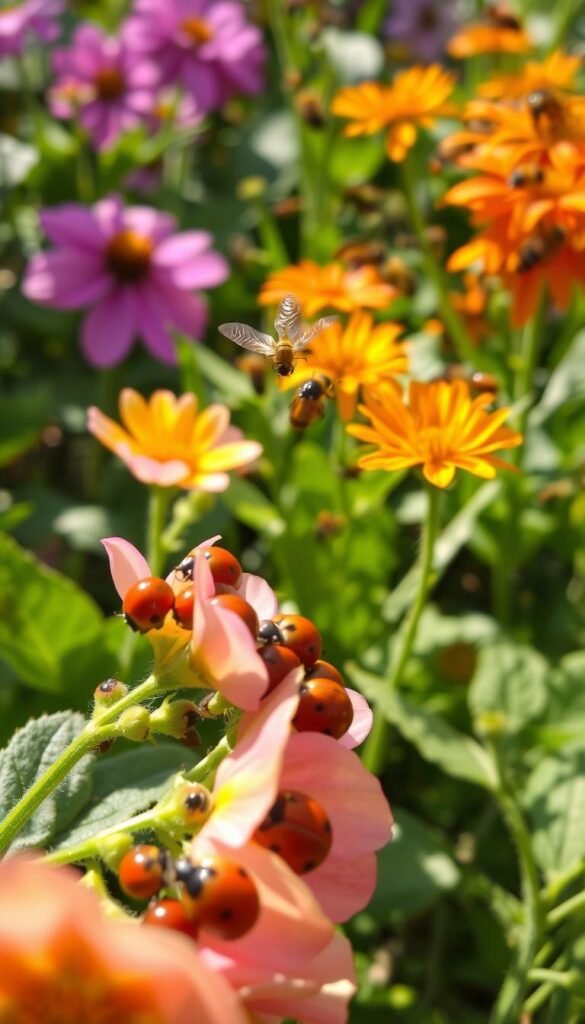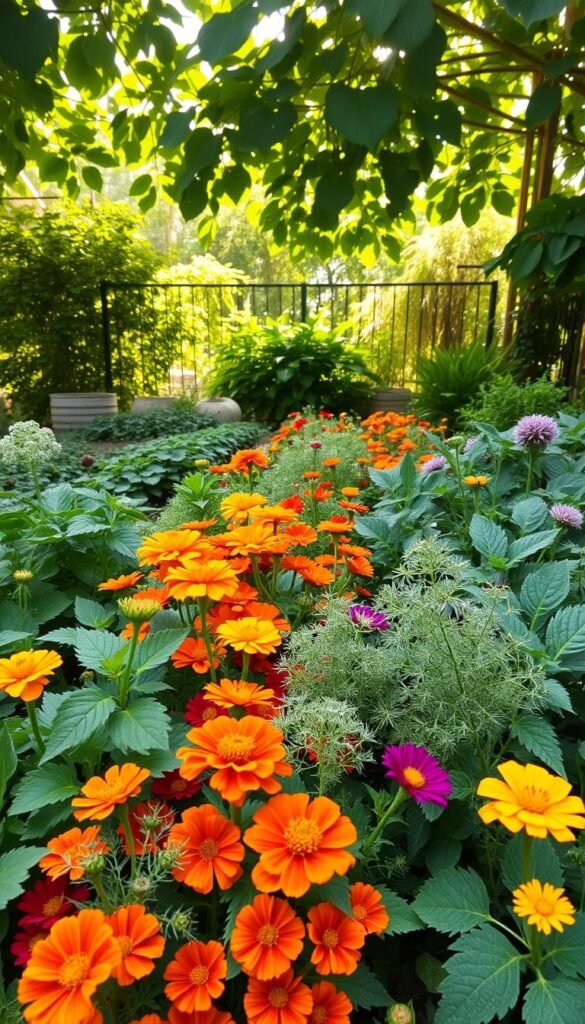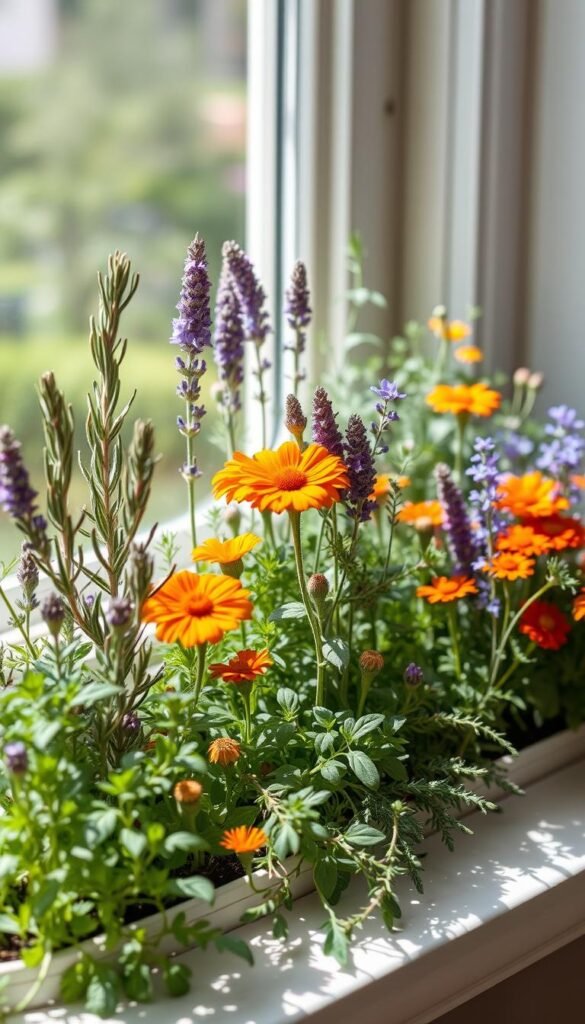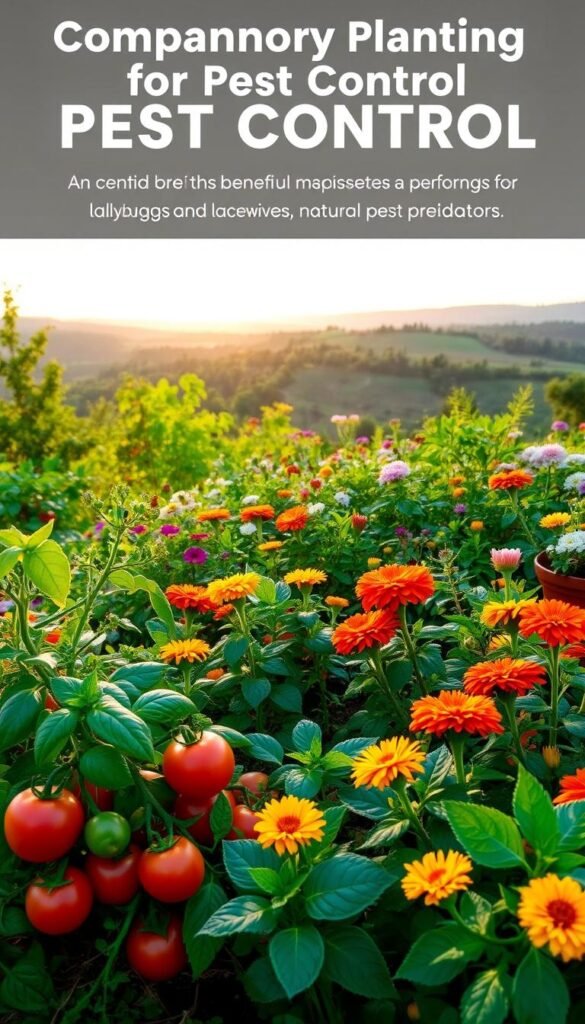Struggling with unwanted bugs in your outdoor space? There’s a natural way to keep them at bay. By strategically pairing certain plants, you can create a healthier, more balanced environment.
This method not only deters garden pests but also boosts pollination and soil health. For example, marigolds repel beetles, while basil keeps flies away from tomatoes. It’s a win-win for your greenery.
Want to learn how simple pairings like garlic near roses or beans with corn can make a difference? Discover proven plant partnerships that work wonders. Let’s explore how nature’s teamwork can solve your bug problems.
What Is Companion Planting and How Does It Work?

Plants communicate in ways that benefit your soil and keep bugs away. This strategy, called companion planting, pairs species that support each other’s growth. Think of it as teamwork—where one plant’s strengths cover another’s weaknesses.
The science behind plant partnerships
Some greenery releases natural chemicals to deter pests. For example, garlic emits sulfur compounds that repel aphids. Basil shields tomatoes by confusing harmful insects with its scent.
Others improve soil health. Legumes like peas add nitrogen, while daikon radishes break up compacted earth. Even squash leaves help by shading the ground like living mulch.
How companion planting differs from monoculture
Growing just one crop invites trouble. Pests spread faster when their favorite meal is everywhere. But mixing plants creates diversity—confusing bugs and attracting helpful predators.
Take basil and tomatoes: the herb’s shade reduces water loss, while its aroma masks the tomato’s scent from pests.
“Nature never farms without diversity. It’s our best pest control.”
For more ways to pair plants seasonally, explore these science-backed combinations. Your garden’s balance starts with the right neighbors.
Why Companion Planting Is Your Best Defense Against Garden Pests

Tired of battling bugs without harsh chemicals? Strategic plant partnerships offer a safer, longer-lasting solution. Unlike synthetic sprays, these natural alliances strengthen your garden’s resilience over time.
Natural pest repellents vs. chemical pesticides
Chemical pesticides kill pests but harm beneficial insects and soil health. Plant-based defenses, like marigolds’ limonene, deter whiteflies without collateral damage. A University of Maryland study found marigolds slash aphid populations by 50%.
| Method | Pros | Cons |
|---|---|---|
| Chemical sprays | Fast results | Harms pollinators, soil degradation |
| Plant partnerships | Sustainable, boosts biodiversity | Requires planning |
Boosting biodiversity for a healthier garden ecosystem
Diverse plantings disrupt pest breeding cycles. Nasturtiums act as “trap crops,” luring aphids away from veggies. Meanwhile, hoverfly larvae devour 1,000 aphids each—nature’s pest control at work.
Lacewings and ladybugs thrive in biodiverse spaces. Their larvae eat 200+ mealybugs weekly. By mixing flowers, herbs, and veggies, you create a balanced ecosystem where pests rarely dominate.
Top Companion Plants for Natural Pest Control

Nature’s best defenders are already growing in your backyard. These companion plants repel bugs, lure pests away, and even enrich your soil—all without sprays. Here’s how to deploy them strategically.
Marigolds: The all-purpose pest deterrent
French marigolds (Tagetes patula) release alpha-terthienyl, a compound that suppresses nematodes. Their bright blooms also deter beetles and whiteflies. Plant ‘Lemon Gem’ near tomatoes to fend off thrips, or ‘Crackerjack’ to discourage rabbits.
Pro tip: Space 3 marigolds per 10-foot row of tomatoes. Their roots protect against soil-dwelling pests while attracting hoverflies.
Nasturtiums: Trap crops for aphids and beetles
These vibrant flowers act as sacrificial trap crops, drawing aphids away from veggies like zucchini. Aphids prefer nasturtiums’ tender leaves, leaving your squash unharmed.
Interplant them with cucumbers or radishes. Bonus: Their peppery leaves are edible and add zest to salads.
Alliums: Garlic and onions for insect protection
Garlic’s root exudates repel carrot rust flies, while onions deter Japanese beetles (research shows 60% less damage). Plant chives near peppers to ward off spider mites.
DIY spray: Steep crushed garlic and chili in water for 48 hours. Strain and spray on brassicas to deter cabbage moths.
“A border of marigolds is like a moat around your garden—keeping invaders at bay.”
For more eco-friendly pest control tricks, explore these balcony-friendly tips. Your garden’s tiny allies are waiting.
How to Use Trap Crops Effectively

Ever wish pests would target a decoy instead of your prized veggies? Trap crops lure bugs away, acting as sacrificial plants. This smart strategy keeps your main harvest safe while reducing the need for sprays.
Pick the right decoys for common invaders
Blue Hubbard squash is a powerhouse—studies show it attracts 80% of cucumber beetles away from melons. Plant it as a perimeter guard. For tomato hornworms, dill works wonders. Its feathery leaves are irresistible to these pests.
Master the timing and placement
Radishes sown two weeks before cabbages cut flea beetle damage by half. Succession planting is key: sow new trap crops every three weeks for continuous protection.
- Keep decoys within 15 feet of protected plants
- Destroy infested nasturtiums before bugs mature
“A well-placed trap crop is like a bouncer—it keeps the troublemakers occupied.”
With these tactics, your garden becomes a fortress. Pests focus on the decoys, leaving your harvest untouched.
Attracting Beneficial Insects to Your Garden
Your garden’s best defenders might be smaller than you think. Beneficial insects like ladybugs and lacewings devour pests naturally. By planting the right flowers and creating habitats, you’ll recruit these tiny allies.
Top plants that lure predator insects
Washington State University found sweet alyssum boosts hoverfly populations by 300%. These flies’ larvae eat up to 60 aphids daily. Other powerhouse plants include:
- Queen Anne’s Lace – Hoverflies swarm its white blooms near roses
- Dill and fennel – Lacewings lay eggs on their feathery leaves
- Sunflowers – Ladybugs overwinter in their sturdy stalks
Building homes for your insect army
Ground beetles thrive in “beetle banks”—mounds of native grasses. Try these simple setups:
- Ladybug hotels: Bundle bamboo stakes in weathered wood
- Dragonfly ponds: Shallow water features control mosquitoes
- Overwintering sites: Leave brush piles for lacewing cocoons
“A single lacewing larva can eliminate 200 aphids per week. That’s pest control you can’t buy in a bottle.”
Time plantings with pest cycles. Stagger dill blooms to match aphid outbreaks. With these strategies, you’ll attract beneficial insects that work around the clock.
Companion Planting Combinations for Specific Pests

Specific plant combinations act like bodyguards against common invaders. By matching the right defenders to each threat, you create natural barriers where pests lose interest or get confused.
Stopping aphids with herbs and flowers
Basil isn’t just for pasta sauce—when planted near tomatoes, it cuts aphid populations by 40%. The herb’s strong scent masks your veggies’ aroma, making them harder to find.
Try these effective pairings:
- Mint borders around lettuce beds (contain roots to prevent spreading)
- Chives between rose bushes to deter greenflies
- Nasturtium “islands” that lure aphids away from beans
Deterring cabbage moths with aromatic plants
That lacy white butterfly isn’t as innocent as it looks—its larvae devour brassicas. Thyme planted as edging reduces cabbage moth egg-laying by 65%, according to Cornell research.
Create protective hedges with rosemary (space 18″ apart every 4 feet) or interplant sage. Their oils confuse moths seeking host plants. For more aromatic plant strategies, explore these proven layouts.
Controlling squash bugs with strategic pairings
Squash bugs wilt vines overnight, but radishes planted in hills act as decoys. The pests prefer radish leaves, sparing your zucchini. Companion triads work even better:
- Nasturtiums repel cucumber beetles
- Marigolds deter vine borers
- Bush beans fix nitrogen for heavy-feeding squash
“One well-planned plant partnership can replace six pesticide sprays per season.”
Check vines weekly—early detection makes organic solutions more effective. Spot eggs on leaf undersides? A quick soap spray stops them hatching.
Organic Pest Control Methods to Combine with Companion Planting
Organic defenses work best when layered like nature intended. While plant partnerships form your first line of defense, sometimes pests need extra discouragement. These non-toxic tools enhance your organic pest strategy without harming pollinators.
Using neem oil and soap sprays safely
Neem oil disrupts pests’ life cycles when applied every 7-10 days at dusk. A Cornell study found it reduces aphid populations by 90% without affecting ladybugs. For tender leaves, dilute to 1 tsp per quart; tougher plants handle 2 tsp.
Dr. Bronner’s castile soap (2 tsp/gal) smothers soft-bodied invaders. Spray undersides of leaves at dawn when bees are less active. Rinse plants after 4 hours to prevent sunburn.
Physical barriers: Row covers and mesh netting
Row covers create a physical barrier against flying pests while letting in light and rain. AGfabric’s 30g mesh netting blocks 98% of cabbage butterflies according to USDA trials.
Install using these methods:
- Hoop houses with 1/2″ EMT conduit arches every 4 feet
- Secure edges with sandbags (better than staples in windy areas)
- Lift covers for 2 hours midday when squash or cucumbers flower
“A floating row cover is like an invisible shield—it stops pests but lets your plants breathe.”
Common Mistakes to Avoid in Companion Planting
Even the best plant partnerships can fail if basic rules are ignored. Simple errors like overcrowding or mismatched neighbors undo nature’s teamwork. Here’s how to sidestep pitfalls for thriving beds.
Give plants room to breathe
Tight spacing stresses plants, inviting disease. Tomatoes need 24″ between stems for airflow, while bush beans thrive at 6″. Follow these guidelines:
- Carrots and dill: Keep 24″ apart (dill stunts carrot growth)
- Basil and peppers: 12″ spacing maximizes pest protection
- Squash and corn: 36″ prevents competition for nutrients
Steer clear of plant rivals
Some species actively harm others through allelopathic chemicals. Fennel secretes root compounds that wilt tomatoes within 3 feet. Other troublemakers:
- Black walnut trees: Juglone toxin kills solanaceous plants (tomatoes, peppers)
- Beans and onions: Onions inhibit bean’s nitrogen-fixing bacteria
- Mustard greens before brassicas: Attracts shared pests
“Plants whisper warnings—listen when they refuse to grow together.”
Mediterranean herbs like rosemary clash with water-loving squash. Group plants with similar needs to avoid irrigation conflicts. Your garden’s success hinges on smart pairings.
Transform Your Garden with Companion Planting
Ready to turn your outdoor area into a thriving, balanced garden ecosystem? Studies show 92% of gardeners cut chemical use after trying these natural methods. Start small—pair basil with tomatoes to control pests while boosting flavor.
Begin with these steps:
- Week 1: Plant marigolds near veggies to deter beetles
- Week 2: Add dill to attract aphid-eating lacewings
- Week 3: Rotate trap crops like radishes for continuous protection
Adjust plantings seasonally—swap summer nasturtiums for fall chrysanthemums. Join local organic gardening groups to swap tips. Nature’s teamwork makes growing easier and safer.
Your first pairing is just a seed away. Dig in!






